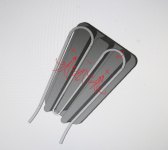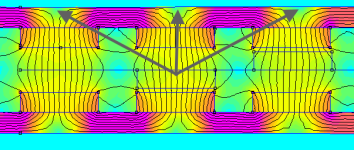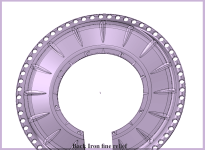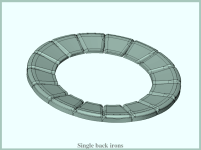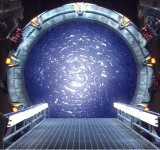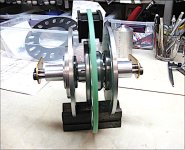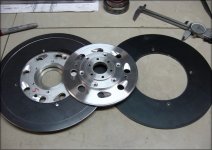Lots of headaches in trying to find the proper pole arc, (magnet width), for these magnets. It doesn't look like theres
going to be any simple explanation, or formula, and I'm finding out that this 'one simple thing' is tied into cogging torque,
torque ripple, air gap flux density/ leakage, and magnet end leakages,and the entire torque, and motor efficiency is
affected by it.
I don't have it quite figured out yet, but heres some of what I've found so far.
Pole pitch, is the largest width that a magnet can take up. On this motor, if I place 16 pole magnets around the back iron
end to end so that they touch, that would be the pole pitch of each magnet.
Pole arc, is the actual width of the magnet.
It's usually, (but not always), smaller than the pole pitch,.. leaving spaces between the magnets. The difference between
the size of the arc and pitch is called the 'pole pitch to pole arc ratio'.
This ratio is what were after, and is usually expressed in fractions of 1,.. like ,25, .05, .75, .9, or 1, and so on.
It can also be expressed in radial degrees.
Two ways to show ratio;
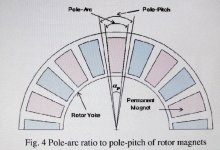
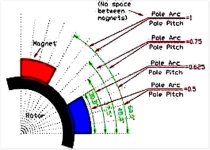
A motor has 180 electrical degrees, and 360 mechanical degrees. So the 180 electrical degrees are what we use. A pitch
that takes up 30 degrees would be expressed as 30/180.
'Coil' pitch and arc are done the same way.
Obviously, the larger the ratio,,, say, one to one, where the arc and pitch are the same size,., or the magnet is as wide as
it can possibly be,.. the more torque a motor will have. But it may lead to excessive cogging torque, and ripple.
One of the main reasons for having a little smaller ratio, is to find the ratio that causes the least amount of cogging torque,
which is a bad thing for motors, as it leads to inefficiency's and noise. Other things to adjust ratio's for, are torque ripple
and flux leakage, which also need to be taken into account, to attain the most perfect ratio number.
The ratio is always a bit of a compromise.
I'm don't really think I need the 'perfect' ratio at this point,.. I'm more or less after a good average number that will do the job. Finding the perfect ratio requires computer programs and calculations beyond my abilities for now.
It's a little too early to tell, and I have a lot of studying to do yet, but at the moment that number seems to be around .75,
or a magnet about 3/4 the size of the pitch. That would leave a 1/8 gap on either side of a pole magnet.
Lots of info to go through yet.
